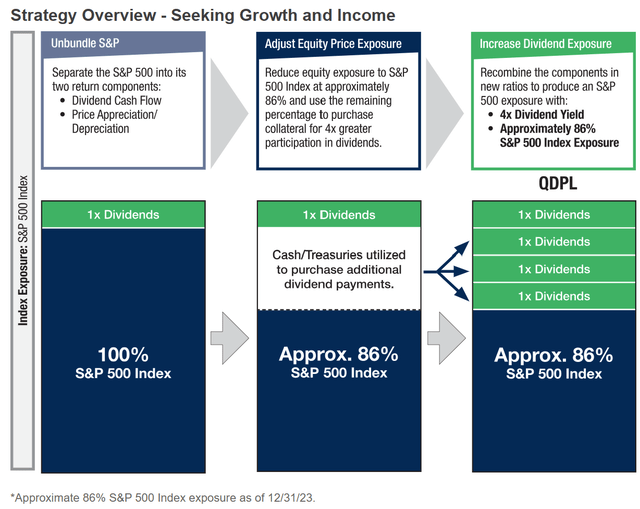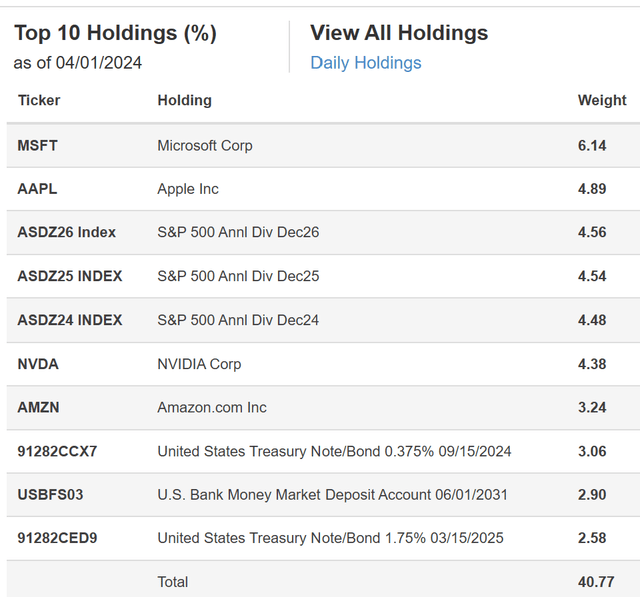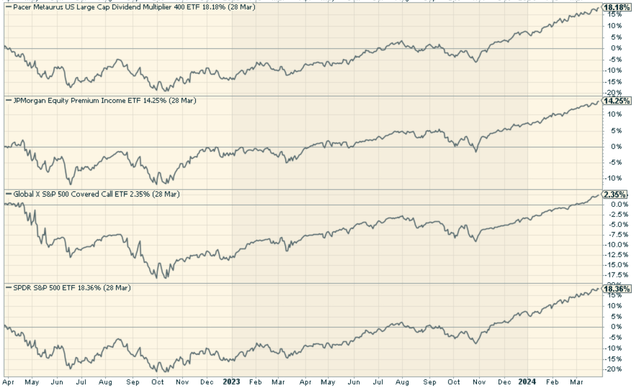When it comes to investing in the stock market, investors are always on the lookout for innovative strategies that can provide them with growth and income. And Wall Street is always happy to provide them. To that end, the Pacer Metaurus US Large Cap Dividend Multiplier 400 ETF (NYSEARCA:QDPL) is certainly different and an approach I haven’t come across before.
QDPL is an exchange-traded fund, or ETF, that seeks to track the total return performance of the Metaurus US Large Cap Dividend Multiplier Index – Series 400. The fund achieves this by investing approximately 86% of its assets in the underlying holdings of the S&P 500 (SP500), while the remaining percentage is used to purchase collateral for 4x greater participation in dividends. This unique approach allows QDPL to provide investors with exposure to the dividend cash flow of the S&P 500, while also maintaining a significant portion of the index’s equity price exposure.
paceretfs.com
The fund, which was launched on July 12, 2021, has garnered approximately $315 million in assets. QDPL charges a total expense ratio of 0.60%, following a reduction in management fees effective February 1, 2024. This expense ratio is quite a bit higher compared to the average equity ETF expense ratio of around 0.16%.
ETF Holdings and Sector Composition
To better understand QDPL’s investment strategy, let’s take a closer look at its top holdings and sector composition. While QDPL primarily invests in the underlying holdings of the S&P 500, it also holds a portion of its assets in dividend futures contracts. This combination allows the fund to provide investors with exposure to both the dividend cash flow and price appreciation/depreciation of the S&P 500.
paceretfs.com
Peer Comparison
Two notable competitors of QDPL are the JPMorgan Equity Premium Income ETF (JEPI) and the Global X S&P 500 Covered Call ETF (XYLD). Both funds employ different strategies to generate income and provide exposure to the S&P 500.
JEPI focuses on writing covered call options on the S&P 500 to generate premium income, while XYLD also writes covered calls but with a focus on a global portfolio. These strategies aim to enhance income potential but may cap the upside potential of the underlying index.
From a total return perspective, QDPL has done better than JEPI and XYLD, and has slightly underperformed SPY. No surprises given the S&P focus of the fund in a cycle that has largely just favored the S&P 500 over most other major market proxies.
stockcharts.com
Pros and Cons of Investing in QDPL
As with any investment, there are both advantages and disadvantages to consider when investing in QDPL.
Pros of Investing in QDPL
-
Enhanced Dividend Exposure: QDPL provides investors with exposure to 4x the dividend yield of the S&P 500, making it an attractive option for those seeking higher cash flow.
ycharts.com
2. Moderate Equity Exposure: QDPL offers a modest reduction in equity exposure compared to the S&P 500, which may appeal to investors looking for a more conservative approach.
3. Diversification: By investing in the underlying holdings of the S&P 500, QDPL provides investors with exposure to a broad range of companies across different sectors, offering diversification benefits.
4. Historical Outperformance: QDPL has historically delivered on its promise, with 85-90% of the returns of the S&P 500 and over 4x the distribution yield. This track record may be appealing to investors looking for consistent relative yield.
Cons of Investing in QDPL
-
Volatility: While QDPL aims to provide enhanced dividend exposure, it is important to note that dividend futures can be subject to volatility and market fluctuations. This volatility may impact the fund’s performance.
-
Expense Ratio: QDPL charges a total expense ratio of 0.60%, which is slightly higher compared to the average equity ETF. Investors should consider the cost of investing in QDPL and evaluate whether the potential benefits outweigh the expenses.
-
Market Risk: As with any investment in the stock market, QDPL is exposed to market risk. Changes in the overall market conditions and economic factors may impact the performance of the fund.
-
Limited Track Record: QDPL is a relatively new ETF, with a launch date of July 12, 2021. Investors should consider the limited track record of the fund when making investment decisions and carefully evaluate its performance over time.
Conclusion
Pacer Metaurus US Large Cap Dividend Multiplier 400 ETF is an interesting one. With its aim to provide 4x the yield of the S&P 500 while maintaining exposure to the index’s equity price performance, QDPL offers a potential avenue for income-oriented investors seeking growth. It’s basically the S&P 500 where it’s creating a larger part of the total return from dividends as opposed to capital appreciation. I can see how this has value for some investors seeing income. Worth considering if you fit in that category.
Read the full article here









